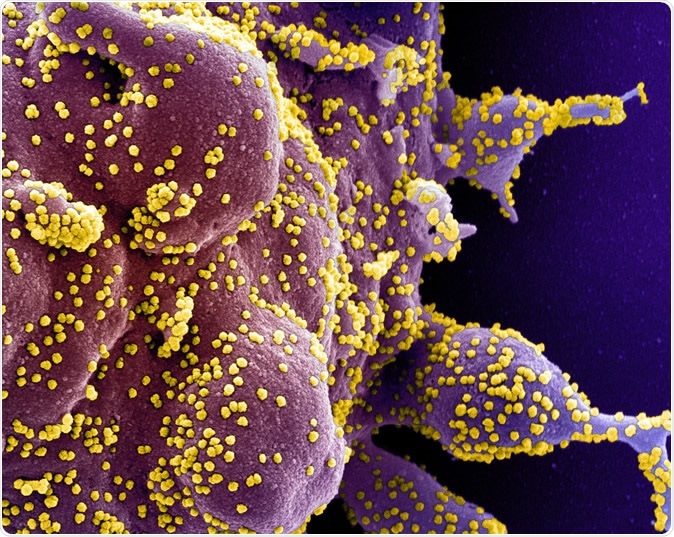A new study published in April 2020 on the preprint server bioRxiv reports that the different levels of susceptibility of various organs to viral attack by the SARS-CoV-2 virus causing the huge pandemic of COVID-19 sweeping around the world can be predicted from the level of expression of two molecules, the ACE2 receptor, and the TMPRSS2 protein.
The SARS-CoV-2 is a catastrophic medical disaster, in which over 2.47 million cases have been reported with more than 169,000 people dead, as of April 20, 2020. The most common cause of death is pneumonia with acute lung injury, acute respiratory distress syndrome (ARDS) being the final event.

Novel Coronavirus SARS-CoV-2 Colorized scanning electron micrograph of an apoptotic cell (purple) heavily infected with SARS-COV-2 virus particles (yellow), isolated from a patient sample. Image captured at the NIAID Integrated Research Facility (IRF) in Fort Detrick, Maryland. Credit: NIAID
However, in some patients, many other organs also suffer severe damage leading to multi-organ failure and even death following infection. This motivated the current attempt to identify the organs that are vulnerable to this virus to understand better how it affects the body.
It is already known that the virus accomplishes cell entry via a molecule called angiotensin-converting enzyme 2 (ACE2), which acts as a receptor for both this virus and the earlier SARS virus. Another protease, called TMPRSS2, within the cell, enhance the transmissibility of the virus. Thus the investigators determined to test the potential usefulness of measuring the level of expression of these two proteins to predict the risk that any given organ will be susceptible to the virus.
How did the scientists distinguish susceptible organs?
The investigators used a method called scRNA-seq to detect the clustering of the gene expression of cells, and thus identify cell types. While most studies indicate that the virus causes mainly lung injury, it is known that the ACE2 receptor is chiefly expressed in the lung’s type II alveolar cells (AT2). This means this cell type is vulnerable to the virus.
The TMPRSS2 is required to initiate the expression of the spike (S) protein, which is key to the entry of the virus and its spread between hosts.
Using this as a standard of reference, other studies have evaluated the susceptibility of other organs. This led to the identification of the nasal epithelium, mouth, airway, and lung as highly vulnerable areas, as were the esophagus, large intestine and pancreas in the gut; the kidney; and the uterus and testes among the reproductive organs.
The current study focuses on identifying the level of expression of the two proteins ACE2 and TMPRSS2 in various cell clusters. They tested organs from 9 systems, such as the cardiovascular system, the nervous system, and the respiratory system.
What did the study show?
The study revealed that in addition to the lung, the other organs that are more susceptible to the infection include the nasal mucosa, the heart, the small bowel, the large bowel, the esophagus, the testes, and the kidney.
The lung AT2 cells are, on average, 0.79% positive for ACE2 expression, and both ACE2 and TMPRSS2 levels are high in these cells. Various nasal epithelial cells also fulfill the same criteria, namely, the presence of clusters of cells that express both ACE2 and TMPRSS2, and a ratio of ACE2-expressing cells to total cells over 0.80%.
The ACE2 expressing cells are much less in the bronchus and trachea, the large airways, indicating the low risk these organs face from the virus.
In the gut, the gallbladder was found susceptible to the infection, due to the high ratio of cells expressing ACE2 and TMPRSS2. The large and small bowel were also found to be high-risk, along with the esophagus.
The brain regions at risk for viral infection with COVID-19 include the substantia nigra and the cortex, which means the virus targets these areas, but not the spinal cord, cerebellum, and neuronal epithelium, which are low-risk for infection with COVID-19. The high-risk cells include the oligodendrocyte precursor cells and the astrocytes.
As mentioned, the fallopian tube epithelium, the ovarian somatic cells, and the testicular cells are very vulnerable to the virus. So is the heart, where both the cardiac muscle cells and the cardiovascular progenitor cells express a high percentage of ACE2 and TMPRSS2. Organs of the urinary system are also susceptible to virus attacks.
Assessing risk levels based on ACE2/TMPRSS2
The organs at high risk for viral infection were classified into three levels of risk, namely, most susceptible – lung, large bowel, fallopian tube, and nasal airway epithelium; moderate risk – kidney, small bowel, and testis; and low-risk. Certain organs such as the esophagus, gall bladder, heart, and brain are shown to be organs at risk from the infection
The authors say their use of part of the organs or living tissue may have led to overlooking more vulnerable organs. They call for clinical confirmation and more advanced testing of susceptible organs to validate their findings.
Important Notice
bioRxiv publishes preliminary scientific reports that are not peer-reviewed and, therefore, not be regarded as conclusive, guide clinical practice/health-related behavior, or treated as established information.